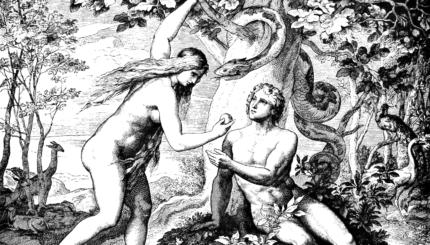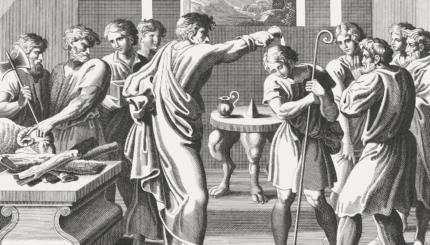Jews read sections of the Torah each week, and these sections, known as
parshiyot, inspire endless examination year after year. Each week we will bring you regular essays examining these portions from a queer perspective, drawn from the Torah Queeries online collection, which was inspired by the book Torah Queeries: Weekly Commentaries on the Hebrew Bible. This week, Noach Dzmura charges us not to forget the Torah’s “good soldier.”
This Torah portion encompasses almost four chapters and is the source of more than 70 of the 613 mitzvoth. Because the parasha seems at first glance to be disjointed and chaotic, I spent time studying its literary themes and narrative structure. There appears to be an overarching meta-narrative to the parasha which suggests that the ethical behavior of soldiers, both at home and in the military encampment, will lead to the ultimate victory of Israel and the acquisition of the land that is God’s promise. The “meta-narrative” is difficult to identify, appearing via a number of successive but marginally related instances of case law. Like a tapestry, we can ultimately make sense of a welter of instances by stepping back and looking at the pattern from a distance. Oftentimes this kind of analysis is a way to grasp a “macro-vision” of Queer Wisdom (in this instance I mean “queer” in the sense of “secret” “hidden” or “mysterious”) from a text that is explicitly anti-Queer when viewed up close. The meta-narrative appears explicitly in the beginning, the middle, and at the end.
The meta-narrative begins (Deuteronomy 21:10-14) by identifying the boundaries of ethical behavior for an individual soldier. The middle segment of the meta-narrative is the definition of an Israelite man, and the meta-narrative ends by encapsulating the essence of Israelite masculinity.
Woven into the meta-narrative are a series of instances of case law. Structurally, each “case” encapsulates a legal scenario that links to its successor by means of a common theme. The result is a daisy chain of loosely-linked cases, and a movement of themes that is practically symphonic. The first case describes the compassionate (at least for the ancients) treatment of a captive woman taken by a soldier as wife. A woman captured in battle, desired by a soldier, is required to undergo a ritual transformation from “captive” to “mourner” to “wife.” After possessing her, a husband may divorce her, but while he may “send her away” he may not profit by selling her into slavery.
A narrative on the theme of “wife” becomes the common thread grabbed up by the next case, which concerns a man with two wives, one of them loved and one of them hated, and the legal inheritance of the firstborn son who emerged from the womb of the hated wife (Deuteronomy 21:15-17). Through this literary device of “cases,” the explicit theme of a soldier’s behavior has become secondary to the theme of an Israelite man’s home life, adding depth and character to the personage of a “soldier” as simply a taker of the spoils of war. A soldier is also a man with responsibilities to his family.
The next theme in the daisy chain is “sons,” and the issue is the administration of a death-sentence to a rebellious son (Deuteronomy 21:18-21). This case outlines the boundaries of the soldier’s parental responsibility. (I am skipping some cases here for brevity.)
The meta-narrative began with the ethical behavior of a soldier toward the human spoils of war, while the daisy-chained themes in the parasha started with the common thread of wives and moved from there to sons, and from there to capital punishment (the cases I skipped). Such a daisy-chain is often found in early written texts, which prior to their history as “text” to be read, were first law codes that were spoken. Linked themes are an aid to memory. In my reading, the cases also serve to contextualize the meta-narrative, and (in this parasha) the characteristics of an idealized soldier. It is as though the compositor of this text were using these instances of case law to illuminate the contours of the Ideal Soldier.
Chapter 22 begins with the legal theme of ethical management of lost property, and is one oft-cited source in Jewish canon for the idea of “ethics” as a Jewish core value. I think, given the meta-narrative I am hypothesizing, that the issue of lost property answers the question, “How does a soldier behave toward members of his community, and even toward his enemy in times of peace?” According to the text in verse 1 through 4, he is obligated to care for lost livestock or possessions until the owner comes to claim them. Furthermore, he can’t ignore a neighbor’s troubles, but must assist, as though the person whose ox fell under a heavy burden were a member of the family.
Chapter 23 is the midpoint of the parasha, and here at the midpoint the meta-narrative is brought back into the text implicitly. If an Israelite soldier is an Israelite man, how does one define an Israelite man?
The first verse in Chapter 23 concerns whom the Israelite man may marry, and taking up the theme of “an Israelite man,” the next verses (2-9) define the physical and genetic constitution of an Israelite man in good standing with the community. To be a member of the Assembly, these verses tell us, a man may not be the product of an unlawful union and he may not be castrated or genitally wounded, and he may not be a member of certain population groups even after the third generation, or certain other population groups (ostensibly more offensive to God) up to the tenth generation.
This is perhaps the most difficult passage in the entire parasha. In addition to demanding racial purity and a standard of physical perfection that eliminates many of us who are physically challenged, it excludes from the Assembly of Israelites, (the body who comes together to make decisions in the Israelite community), all those persons who are female, gender-variant, and homosexual (according to the first verse an Israelite man must be married to an appropriate female). But, with respect to the meta-narrative, we come to understand that an ancient Hebrew soldier was a man of a certain type.
The next verses (10-15) describe what a modern ethical sensibility must consider oxymoronic: a sacred war camp. The verses describe how a military encampment is to be maintained as a sacred space.
Chapter 24 once again moves to the home front in which we learn through illustrative cases that the Ideal Soldier is not a newlywed, and that he is an ethical businessman.
Chapter 25, the tail end of our parasha, concerns disputes between Israelites, or a kind of “internal warfare.” Chapter 25 concludes with a curse against Israelites who commit fraud of any sort. Their curse is that what befell Amalak, the arch-enemy of the Israelites, shall befall the Israelite that commits fraud: he will not be remembered among the Children of Israel.
The meta-narrative ends with the idea that “being remembered” is the essence of masculinity. A soldier is a family man and a citizen and a businessman who behaves ethically both in wartime and in times of peace. The meta-narative concludes on the idea implicit in this final chapter that a soldier who behaves fraudulently in any realm will not have “a remembrance” (zekher) and is consequently not male (zakhar).
As a friend pointed out to me, human communities tend to remember odd behaviors, whether oddly good or oddly bad. We haven’t forgotten Hitler or Amalek. The person we forget is “the good soldier,” the person who blends into the crowd.
What does this tell us about the Ideal Soldier described in the meta-narrative?
Torah
Pronunced: TORE-uh, Origin: Hebrew, the Five Books of Moses.


